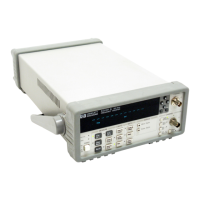Contents
Operating Guide vii
Limits Testing Example 5—Sending the Limit-Detect Output to
the RS-232 Serial Port 2-38
Using the DISPLAY Digits Keys 2-39
Overview of the DISPLAY Digits Keys 2-39
To Use the DISPLAY Digits Keys 2-40
Using CHANNEL 1 Input Conditioning Keys 2-41
Overview of Trigger/Sensitivity Menu 2-41
To Use the Trigger/Sensitivity Key to Adjust Counter’s Trigger
Voltage and Sensitivity Levels 2-44
Overview of Input Conditioning Toggle Keys 2-47
Using the Save and Recall Menus 2-48
Overview of Save and Recall Functions 2-48
To Use the Save Function 2-49
To Use the Recall Function 2-50
To Unsave a Measurement Setup 2-51
Using the Print Menu 2-52
Overview of the Print Menu 2-52
To Use the Print Menu 2-52
Using the Utility Menu 2-53
Overview of the Utility Menu 2-53
To Set the GPIB Address 2-54
Selecting Operating Mode (Talk/Listen, Talk-Only) 2-54
Setting the GPIB Address 2-54
To Choose the Timebase Source 2-55
To Run the Self-Test Routines 2-56
Overview of the Self-Test Routines 2-56
Example Procedure for Running the Self Test 2-57
To Configure the RS-232 Serial Port for Printing 2-58
Setting the Hardware Pacing 2-58
Setting the Baud Rate 2-59
Setting the Parity 2-59
Setting the Software Pace 2-59

